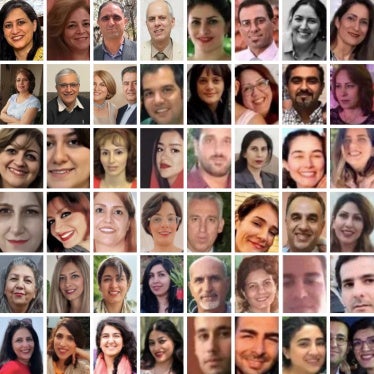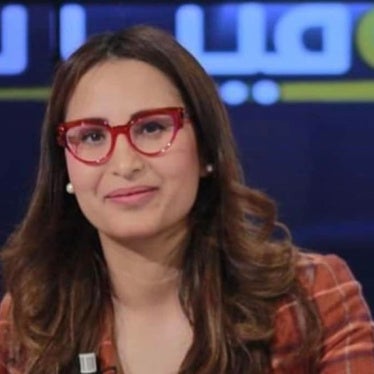(Sanaa) – Yemeni authorities should immediately investigate the use of unnecessary lethal force against demonstrators in Sanaa on September 7 and 9, 2014. It should hold military personnel and other security forces found responsible to account. Altogether eight protesters and an ambulance driver were killed and at least 67 were wounded.
Houthis, a Zaidi Shi’a resistance group from northern Yemen, held demonstrations in Sanaa, the capital, to protest the government of President Abd Rabbu Mansour Hadi. The heavy-handed response by state security forces resulted in apparently unnecessary loss of life and numerous injuries to the demonstrators, Human Rights Watch said.
“Yemeni soldiers firing live ammunition into peaceful crowds is all too reminiscent of the killings of protesters that marked the previous government’s attempts to crush the 2011 uprising,” said Joe Stork, deputy Middle East and North Africa director. “President Hadi needs to take immediate steps to ensure full accountability or these killings will permanently stain his record.”
The September 7 protest blocked the main road to the airport near the Electricity Ministry. A demonstrator told Human Rights Watch that Houthi protesters were sitting on the road at about 5:30 p.m. when soldiers and Special Security Forces (SSF), paramilitary troops under the Interior Ministry, arrived with water cannons on trucks and without warning started firing water and teargas at the crowd. The demonstrators responded by throwing stones from the street. Soldiers then fired assault rifles at the crowd. Two witnesses and doctors from hospitals receiving the casualties told Human Rights Watch that two people were killed. One shot was in the back, and another choked on teargas and died two days later.
On September 9 at about 9 a.m., several thousand Houthi protesters began walking down a road near Sanaa University toward the Sanaa Radio building and the prime minister’s office, calling for the government to step down, witnesses said.
Soldiers and SSF personnel were at the scene, protesters told Human Rights Watch. Several said they also saw some armed men from an unknown force wearing all-black uniforms, including gloves, masks and helmets. They also described a 12.7 mm heavy machine gun mounted on an armored vehicle, and another large-caliber double-barreled weapon on an armored vehicle.
Without warning, the soldiers first used water cannons and teargas, and then started firing live ammunition at the protesters. Human Rights Watch saw video footage that shows government forces opening fire on the protesters, and protesters and medics carrying away the dead and wounded. Protesters told Human Rights Watch that they saw two demonstrators struck in the head by bullets.
“Suddenly there was shooting everywhere and I turned around to my friend and saw a bullet blow his head off,” one said.
A 21-year-old protester told Human Rights Watch that he was stopped at a military and SSF checkpoint at about 11 a.m. as he was trying to reach the demonstration. He ignored the checkpoint officers who told him not to proceed and kept walking:
Then about five soldiers grabbed me from behind to stop me. I pushed one and so they started hitting me with the butts of their rifles, all over my head, back and chest. I did not see who fired his gun but suddenly I heard the shot and felt a sharp pain as the bullet went into my arm. By then I was really bleeding so some the special forces decided to put me in their land cruiser and take me to the hospital. As they were putting me in the car the soldiers were yelling at them and one said, “If you take him to the hospital, you better bring him back here afterward so we can lock him up.”
They took him to the Republican Hospital where he had surgery and persuaded hospital security staff to let him transfer to the Moayyad Hospital.
Armed security forces, possibly snipers, were on the roofs of buildings near the Sanaa Radio Building, according to witnesses and video footage. Government statements said military and other security forces were there to protect the prime minister’s office and Sanaa Radio building.
Four protesters and two ambulance services staff told Human Rights Watch that they saw no protesters with weapons. Video showed several protesters carrying sticks or umbrellas and one throwing a stone, but no weapons were visible.
At least seven people died on September 9 from gunshot wounds, including an ambulance driver who was fatally struck in the back by a bullet while he sat in his marked ambulance after driving it to the area to collect the wounded.
Human Rights Watch researchers viewed three bodies of the dead to confirm their injuries. They also interviewed one protester who was injured on September 7 and three who were injured on September 9; three had gunshot wounds and a third had lost the sight in one eye after being struck by water from a water cannon.
The government’s Supreme Security Committee stated on the evening of September 9 that the protesters had tried to storm the prime minister’s office and Sanaa Radio Building, leading to deaths and injuries among both protesters and the deployed security forces. The government claimed that the security forces guarding the buildings did not use live ammunition and that the deaths and injuries were caused by firing from armed protesters.
Security forces appeared to interfere with attempts by medical personnel to assist the wounded, Human Rights Watch said. A doctor told Human Rights Watch that on September 9 he went with an ambulance to a street close to the demonstration but that soldiers at a checkpoint refused to allow him to go to the aid of the wounded. He said that two soldiers switched off the safeties on their assault rifles, chambered bullets, and pointed their weapons at him.
A security official at the Kuwait University Hospital told Human Rights Watch that he saw a soldier chase a protester who was running toward the hospital gate and raise his rifle to take aim. He said he and other protesters intervened and wrestled the soldier to the ground to disarm him, though one shot went off during their struggle. They locked the soldier in a security room. Soldiers arrived in an armored vehicle to demand his release, and drove through the chained hospital gates and freed him by force when the staff members refused to give him up.
According to hospital records and medical staff at the Moayyad Hospital, Kuwait University hospital, and Republican Hospital, to which the dead and wounded were taken on September 7 and 9, 9 people were killed and at least 67 injured, including 33 with gunshot wounds. The youngest person wounded was 12. Of the eight who died from gunshot wounds, four had been struck in the head, while the rest had been hit in the stomach, back, or chest.
Of those with gunshot wounds, at least three were hit in the back, four in the head, five in the stomach and chest, and eighteen in their arms or legs. Four people had shrapnel injuries. At least 30 demonstrators had fractures and bruises, including three who said they were struck in the face or ribs with rifle butts, according to a doctor at Kuwait University Hospital. Three people were also hit by a military vehicle mounted with a water cannon. Doctors said that about 96 people were treated for the effects of teargas. The government has not provided any casualty figures or details for members of security forces it said were wounded.
When policing demonstrations, Yemeni authorities should abide by the United Nations Basic Principles on the Use of Force and Firearms by Law Enforcement Officials. The Basic Principles provide that all security forces shall, as far as possible, apply nonviolent means before resorting to force. Whenever the lawful use of force is unavoidable, the authorities must use restraint and act in proportion to the seriousness of the offense. Law enforcement officials should not use firearms against people “except in self-defense or defense of others against the imminent threat of death or serious injury.” Even when the use of lethal force is justified, law enforcement officials need to give a clear warning of their intent to use firearms, with sufficient time for the warning to be observed, unless circumstances do not allow it.
The demonstrations in Sanaa follow months of fighting between the Houthis and the Yemeni military and other armed groups active in northern Yemen. The media and local organizations have reported many alleged violations of the laws of war, including indiscriminate attacks on civilians, use of child soldiers, use of anti-personnel landmines, and destruction of hospitals.
In August, Houthi forces took up positions just outside the capital, and demanded the formation of a new government and the reinstatement of fuel subsidies lifted in July. The removal of these subsidies had caused fuel prices to double overnight and sparked mass protests and riots. Officials at the Ministry of Education and Teaching told Human Rights Watch that Houthi forces occupied the Abd al-Latif al-Hamd secondary school in Hiziaz, in southern Sanaa, on September 8, preventing 1,590 students from attending school. There was fighting in and around the school that day between the Houthis and government forces, causing one death, according to an official statement. Houthi forces remained in the school.
Houthi forces, as well as the government and all armed groups in Yemen, should refrain from using schools for military purposes and respect the right of all Yemeni children to an education free from the threat of attack, Human Rights Watch said.
Human Rights Watch has documented two other incidents in Yemen since President Hadi took office in February 2012 in which military and other security forces used unnecessary lethal force. The government has announced official investigations into allegations of unlawful force by the security forces, but no results have been made public. No officials have been held to account for excessive force or unlawful killings, as far as Human Rights Watch has been able to determine.
“The killings in Sanaa show just how important it is for Yemen to break with its repressive past,” Stork said. “The clock is ticking for President Hadi to show that he has embraced the need for change and is committed to ending the long cycle of abuse that has threatened to split the country apart.”






